机器学习~从入门到精通(二)线性回归算法和多元线性回归
发布时间:2024年01月14日
为什么要做数据归一化
一、数据归一化:
1.最值归一化
2.均值方差归一化
import numpy as np
X = np.random.randint(1,100,size=100)
X = X.reshape(-1,2)
X.shape
X = np.array(X,dtype='float')
X[:,0] = (X[:,0]-np.min(X[:,0]))/(np.max(X[:,0])-np.min(X[:,0]))
X[:,1] = (X[:,1]-np.min(X[:,1]))/(np.max(X[:,1])-np.min(X[:,1]))
X
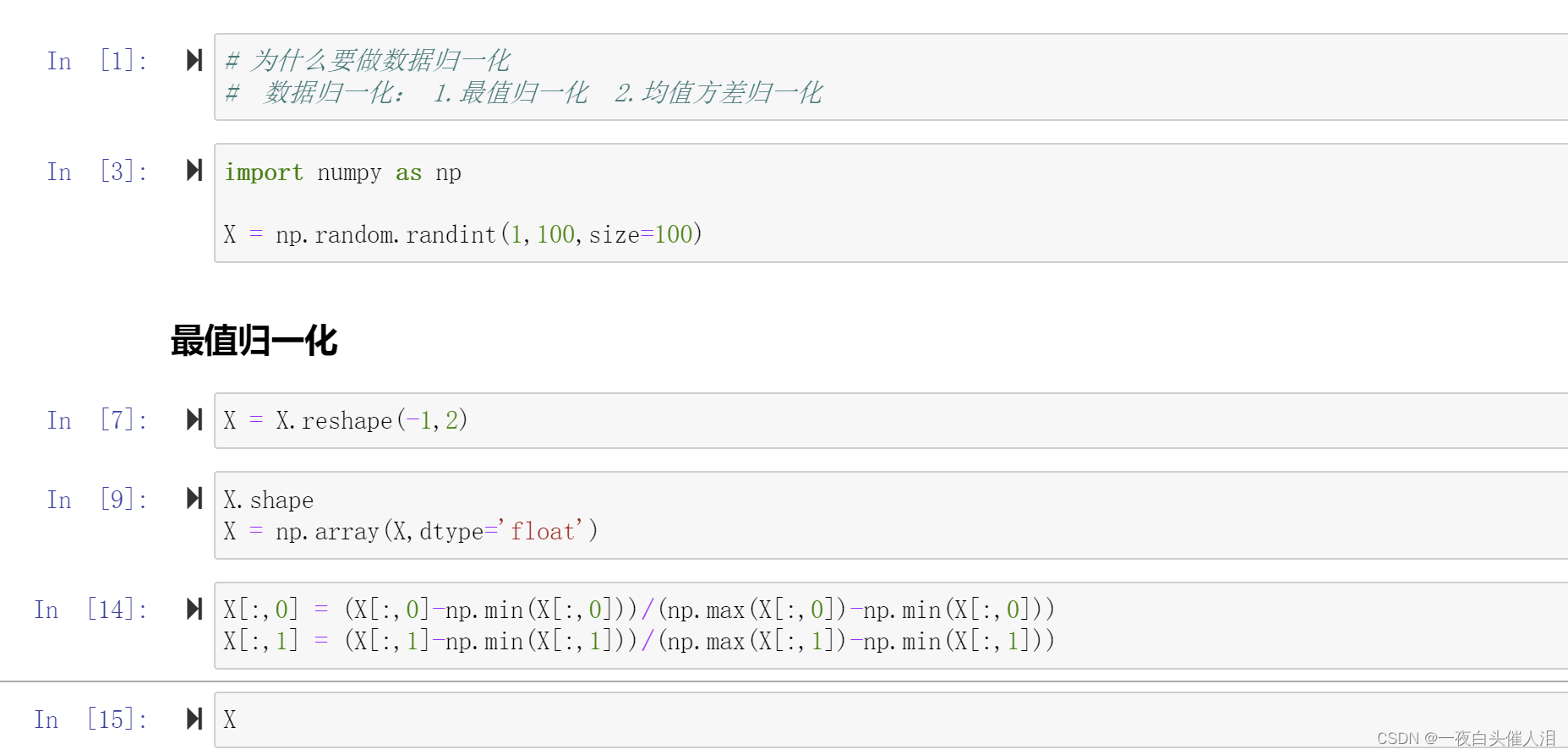
均值方差归一化
X = np.random.randint(1,100,size=100)
X = X.reshape(-1,2)
X = np.array(X,dtype='float')
X[:,0] = (X[:,0]-np.mean(X[:,0]))/np.std(X[:,0])
X[:,1] = (X[:,1]-np.mean(X[:,1]))/np.std(X[:,1])
X
np.std(X[:,0])
np.std(X[:,1])
np.mean(X[:,0])
np.mean(X[:,1])

二、数据归一化的注意事项
import numpy as np
X = np.random.randint(1,100,size=100).reshape(-1,1)
X1 = np.array(X,dtype='float')
from sklearn.preprocessing import StandardScaler
std_scaler = StandardScaler()
std_scaler.fit(X1) # 计算均值和方差
X_std = std_scaler.transform(X1) # 归一化转化
X_std
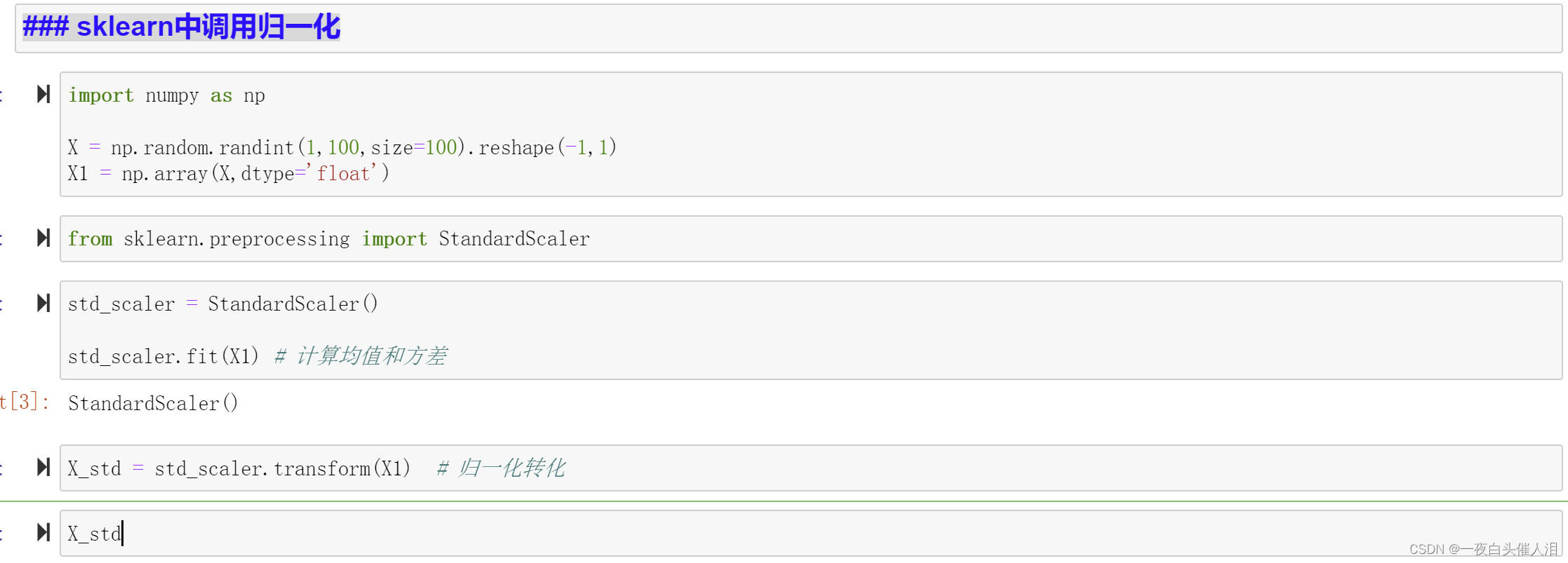
三、鸢尾花数据归一化
import numpy as np
from sklearn.datasets import load_iris
from sklearn.preprocessing import StandardScaler
iris = load_iris()
X= iris.data
y = iris.target
from sklearn.model_selection import train_test_split
X_train,X_test,y_train,y_test=train_test_split(X,y,test_size=0.2)
X_train.shape
std_scaler = StandardScaler()
std_scaler.fit(X_train)
std_scaler.mean_.shape
X_std_train = std_scaler.transform(X_train) # 对训练集特征进行归一化处理
X_std_test = std_scaler.transform(X_test) # 对测试集特征进行归一化处理
from sklearn.neighbors import KNeighborsClassifier
knn_clf = KNeighborsClassifier()
knn_clf.fit(X_std_train,y_train)
knn_clf.score(X_std_test,y_test)
knn_cl1 = KNeighborsClassifier()
knn_cl1.fit(X_train,y_train)
knn_cl1.score(X_test,y_test)
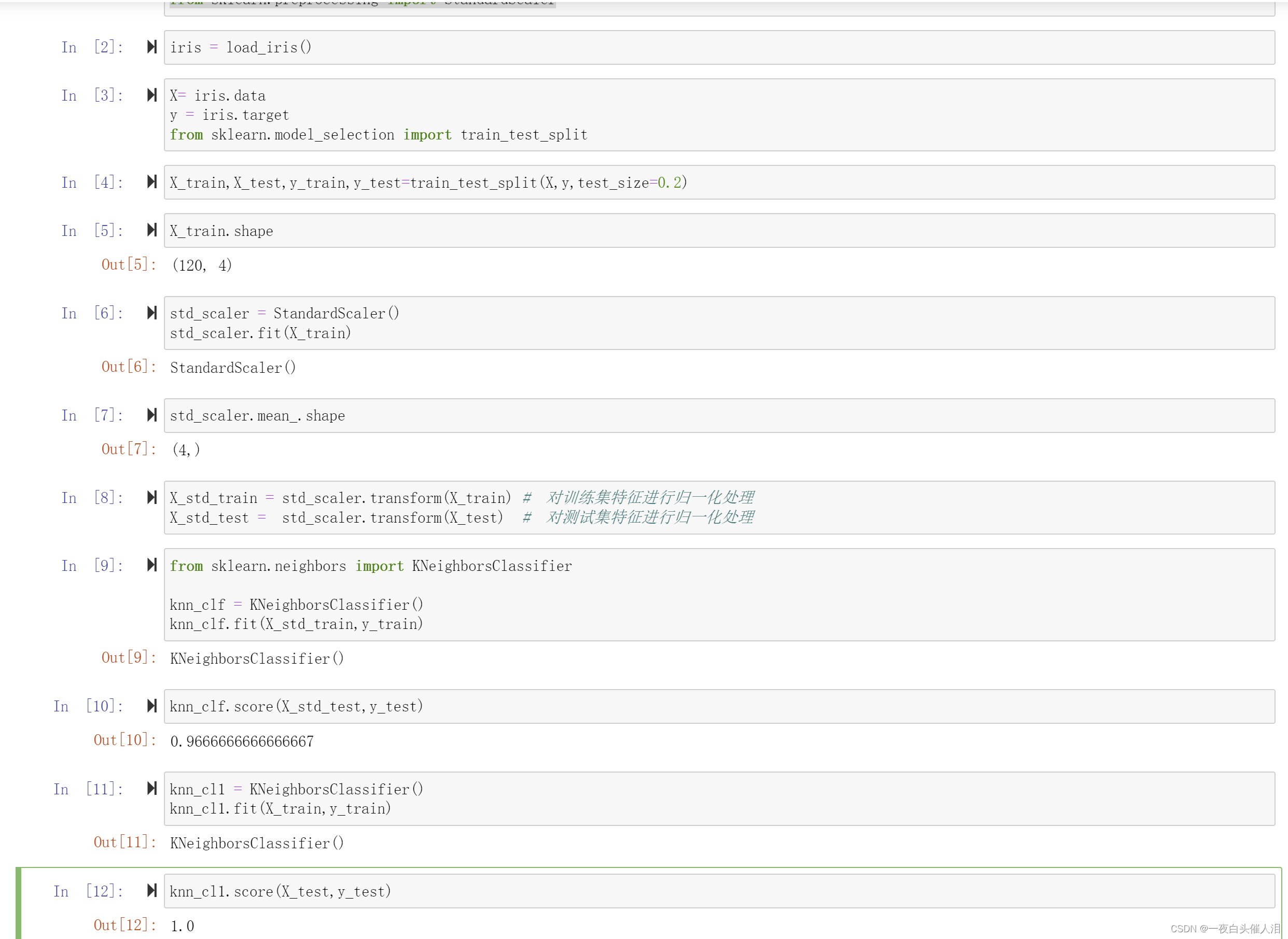
四、knn算法总结
# knn: 天然可以解决分类的算法
# 思想简单,效果强大
# 缺点: 效率很低
# 缺点: 高度数据相关outlier
# 缺点: 预测的结果不具有可解释性
# 缺点: 维数灾难: 随着维度的增加,看似很相近的点,之间的距离会越来越大
五、线性回归
# 线性回归:判断数据的特征和目标值之间具有一定的线性关系
# 最简单的线性回归:样本的特征只有一个,用线性回归法进行预测,叫做简单线性回归
# 推广到样本特征有多个,多元线性回归
# 实现简单,是很多非线性模型的基础
# 结果具有很强的解释性,可以学习到一些真实世界中的知识
# np.sum(|y` - y| )
# np.sum((y` - y)**2)
# 损失函数
import numpy as np
import matplotlib.pyplot as plt
x = np.array([1,2,3,4,5])
y = np.array([1,3,2,3,5])
plt.scatter(x,y)
plt.axis([0,6,0,6])
plt.show()

# y = a*x+b 需要计算出a和b
x_mean = np.mean(x)
y_mean = np.mean(y)
num = 0.0 # 分子
d = 0.0 # 分母
for x_i,y_i in zip(x,y):
num += (x_i-x_mean)*(y_i-y_mean)
d += (x_i-x_mean)**2
a = num/d
b = y_mean-a*x_mean
a
b
y_hat = a * x +b
plt.plot(x,y_hat,color='r')
plt.scatter(x,y)
plt.axis([0,6,0,6])
plt.show()
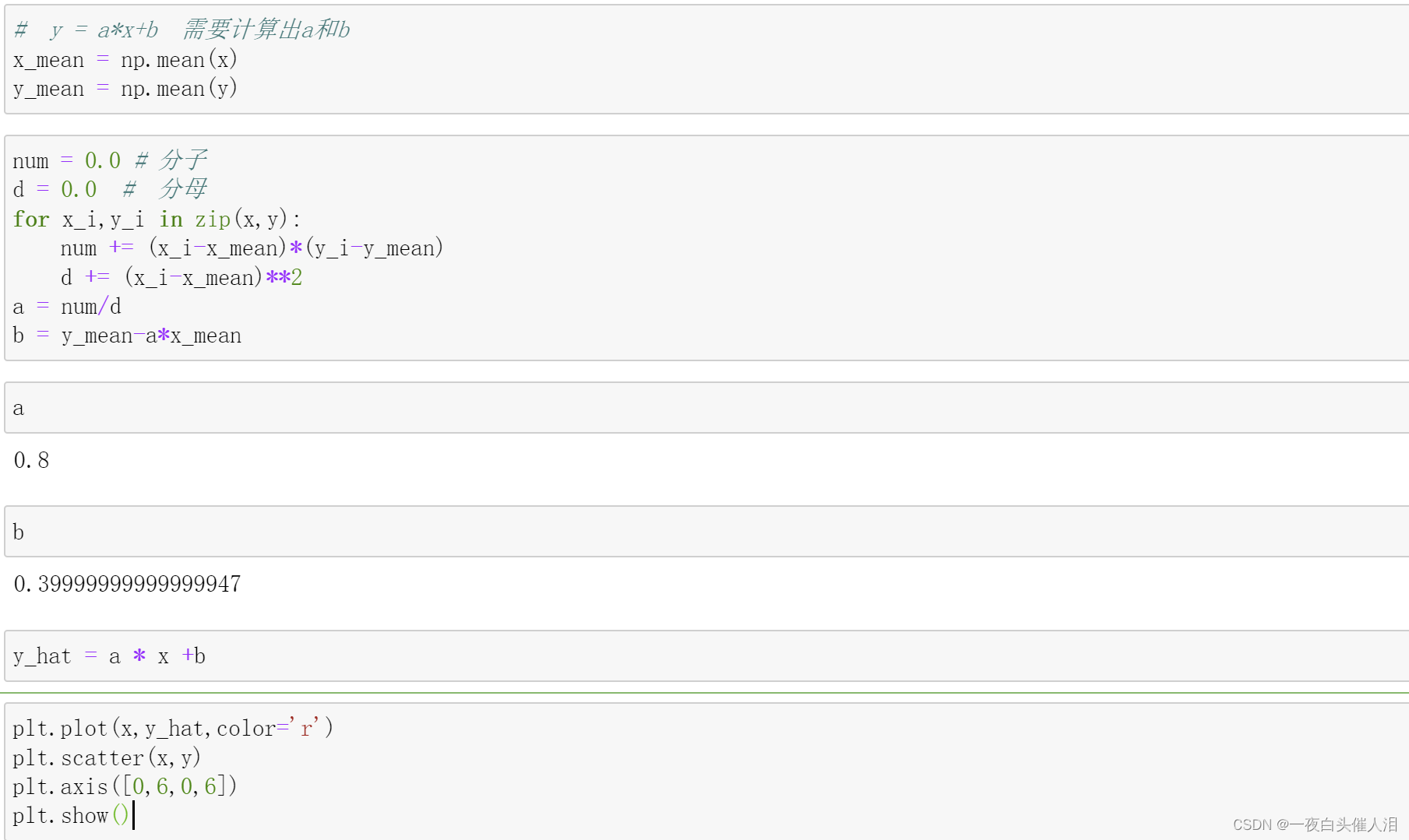

x_predict = 3.5
a*x_predict+b
%run MechainLearning/SimpleLinearRegression.py
lin_reg = SimpleLinearRegression()
lin_reg.fit(x,y)
lin_reg.predict()

SimpleLinearRegression.py
import numpy as np
class SimpleLinearRegression:
def __init__(self):
self.a_ = None
self.b_ = None
self.x_mean = None
self.y_mean = None
def fit(self, x_train, y_train):
self.x_mean = np.mean(x_train)
self.y_mean = np.mean(y_train)
num = 0.0 # 分子
d = 0.0 # 分母
for x_i, y_i in zip(x_train, y_train):
num += (x_i - self.x_mean) * (y_i - self.y_mean)
d += (x_i - self.x_mean) ** 2
self.a = num / d
self.b = self.y_mean - self.a * self.x_mean
return self
def predict(self, x_test):
return self.a * x_test + self.b
moduel_selection.py
import numpy as np
def train_test_split(X, y, test_ratio=0.2, random_state=None):
if random_state:
np.random.seed(random_state)
shuffle_indexs = np.random.permutation(len(X))
test_ratio = test_ratio
test_size = int(len(X) * test_ratio)
test_indexs = shuffle_indexs[:test_size]
train_indexs = shuffle_indexs[test_size:]
X_train = X[train_indexs]
y_train = y[train_indexs]
X_test = X[test_indexs]
y_test = y[test_indexs]
return X_train, X_test, y_train, y_test
from sklearn.neighbors import KNeighborsClassifier
knn = KNeighborsClassifier()
draft.py
import random
random.seed(666)
print(random.random())
print(random.random())
print(random.random())
def random(num):
pass
六、简单线性回归
# 前提:认为数据具有一定的线性关系
# 希望找到一条最佳拟合的直线方程,只针对简单线性回归(只有一个特征值)
# y = ax+b 对于每一个样本点,在这个直线方程上都有一个预测值,预测值和真实值有一定的差距
# 我们希望这些样本到直线方程的差距之和最小
# 如何计算这些差距? |y-y~| sqrt((y-y~)**2)
# loss function 损失函数 希望损失函数达到最小值
from sklearn.linear_model import LinearRegression
import numpy as np
import matplotlib.pyplot as plt
x = np.array([1,2,3,4,5])
y = np.array([1,3,2,3,5])
plt.scatter(x,y)
plt.axis([0,6,0,6])
plt.show()
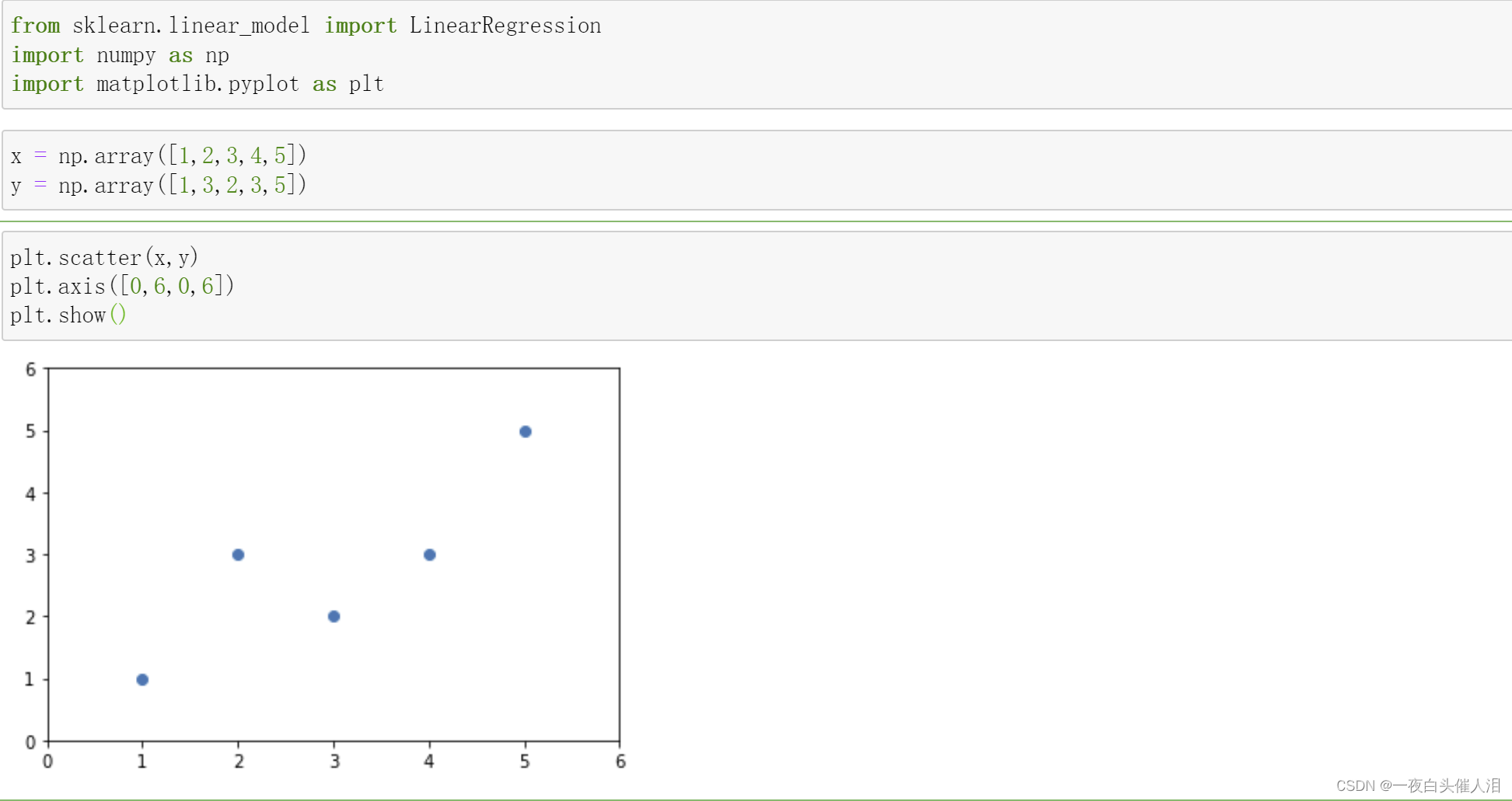
lin_reg = LinearRegression()
lin_reg.fit(x.reshape(-1,1),y)
lin_reg.coef_ # 系数
lin_reg.intercept_ # 截距
plt.scatter(x,y)
plt.plot(x,lin_reg.predict(x.reshape(-1,1)),color='r')
plt.axis([0,6,0,6])
plt.show()

def lin_fit(x,y):
x_mean = np.mean(x)
y_mean = np.mean(y)
num = 0.0
d = 0.0
for i in range(len(x)):
num+=(x[i]-x_mean)*(y[i]-y_mean)
d+=(x[i]-x_mean)**2
a = num/d
b = y_mean-a*x_mean
return a,b
lin_fit(x,y)
def lin_fit2(x,y):
x_mean = np.mean(x)
y_mean = np.mean(y)
num = 0.0
d = 0.0
# for i in range(len(x)):
# num+=(x[i]-x_mean)*(y[i]-y_mean)
# d+=(x[i]-x_mean)**2
num = (x-x_mean).dot(y-y_mean)
d = (x-x_mean).dot(x-x_mean)
a = num/d
b = y_mean-a*x_mean
return a,b
lin_fit2(x,y)
x.shape
y.shape

七、线性回归模型评优
from sklearn.linear_model import LinearRegression
import numpy as np
import matplotlib.pyplot as plt
x = np.array([1,2,3,4,5])
y = np.array([1,3,2,3,5])
lin_reg = LinearRegression()
lin_reg.fit(x.reshape(-1,1),y)
lin_reg.score(x.reshape(-1,1),y)
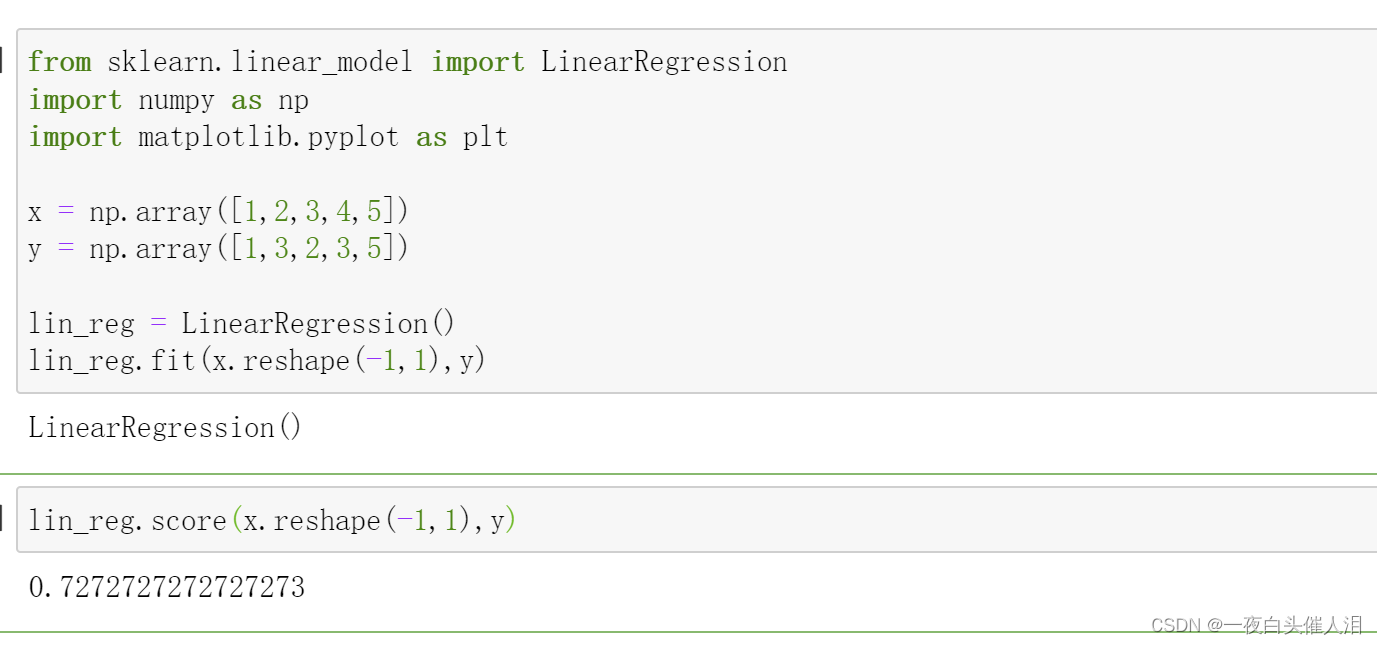
线性回归模型中的误差计算
MSE mean squared error 均方误差
# 为什么均方误差中需要除以样本数量m
def MSE(y_true,y_predict):
return np.sum((y_true-y_predict)**2)/len(y_true)
均方根误差
from math import sqrt
def RMSE(y_true,y_predict):
return sqrt(np.sum((y_true-y_predict)**2)/len(y_true))
绝对平均误差
def MAE(y_true,y_predict):
return np.sum(np.absolute(y_true-y_predict))/len(y_true)
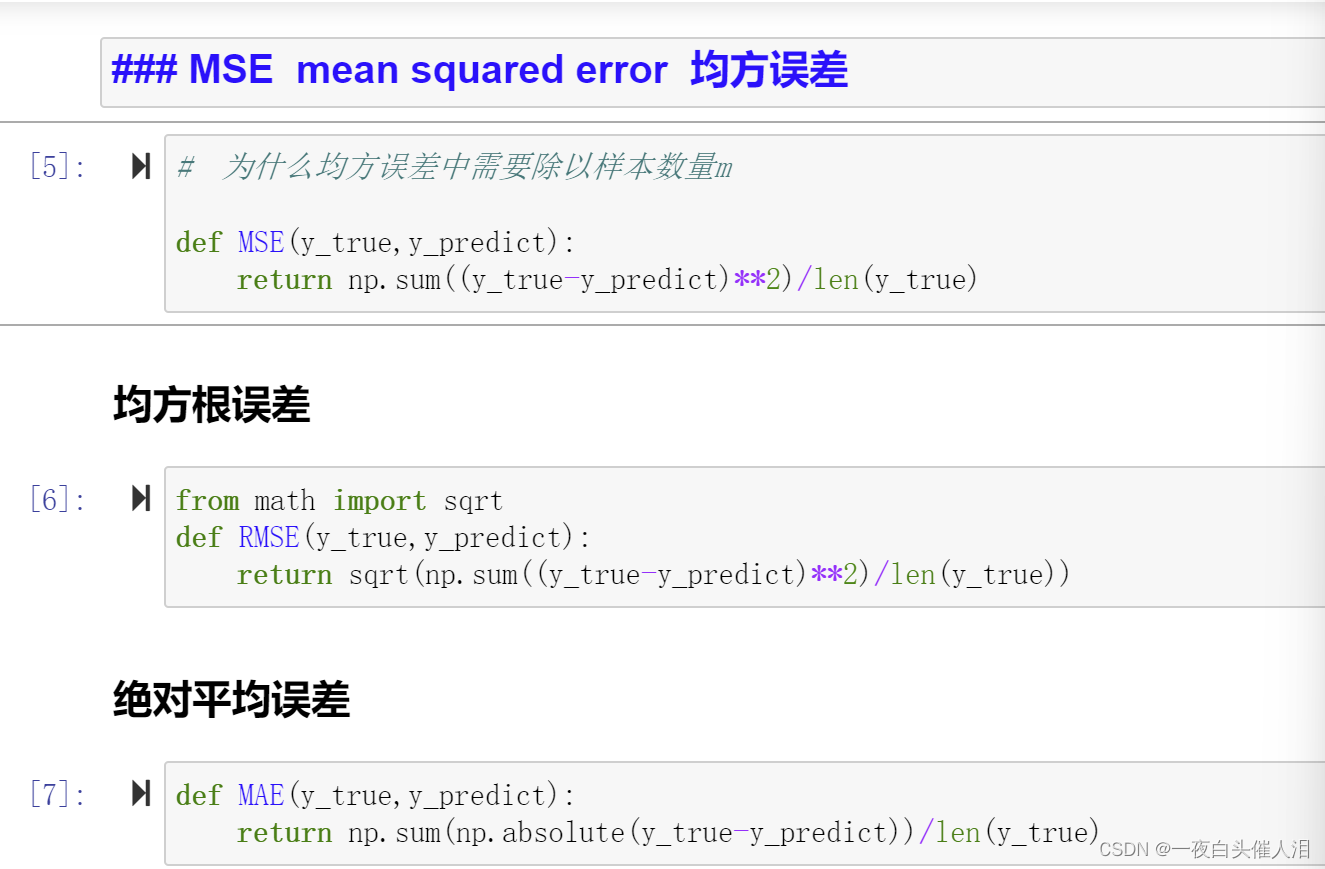
MSE(x,y)
RMSE(x,y)
MAE(x,y)
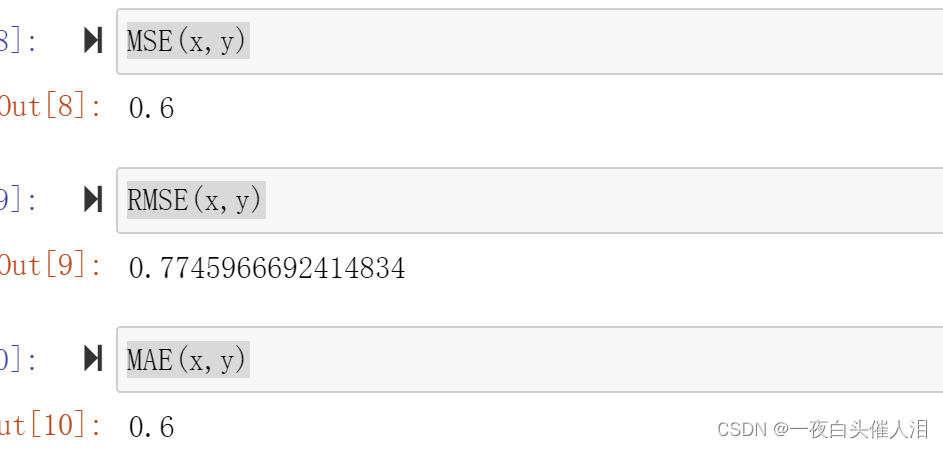
from sklearn.metrics import mean_squared_error,mean_absolute_error
mean_squared_error(x,y)
mean_absolute_error(x,y)
def r2_score(y_true,y_predict):
return 1-MSE(y_true,y_predict)/np.var(y_true)
r2_score(x,y)

R squared error

八、多线线性回归
# 特征值不止一个,叫做多元线性回归
# 通过对矩阵进行转换,加一个x0维度,可以得到求出两个矩阵点乘的最小值问题
# 得到西塔的正规方程解,带入x和y就可以求出西塔
# 西塔是一个n+1 * 1 的矩阵
# 西塔0代表截距,西塔除第一个以外的元素代表系数
from sklearn.datasets import load_boston
boston = load_boston()
print(boston.DESCR)

boston.feature_names
x = boston.data[:,5].reshape(-1,1)
y = boston.target
x.shape
y.shape
from sklearn.model_selection import train_test_split
from sklearn.linear_model import LinearRegression
import matplotlib.pyplot as plt
x = x[y<50]
y = y[y<50]
plt.scatter(x,y)
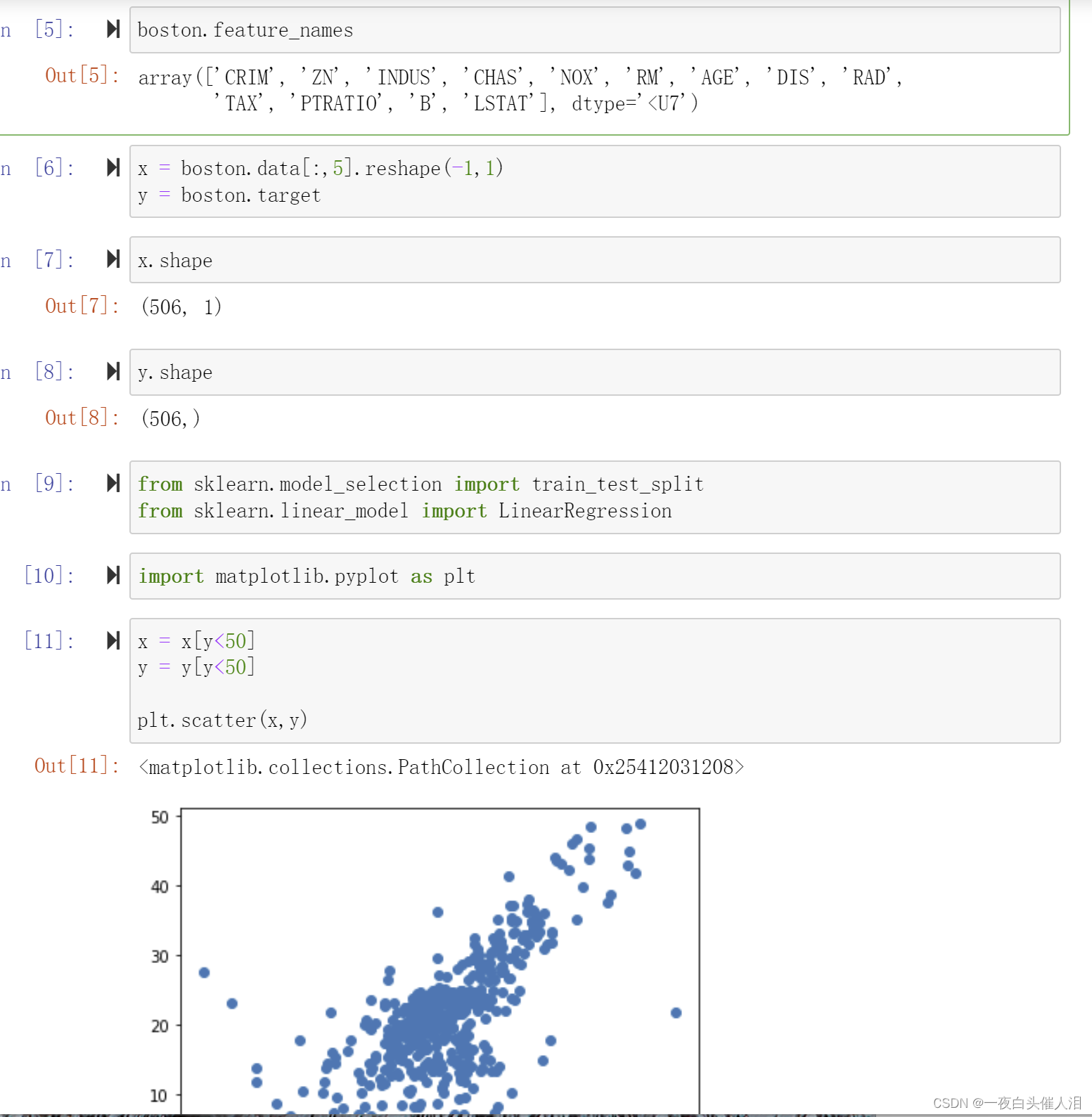
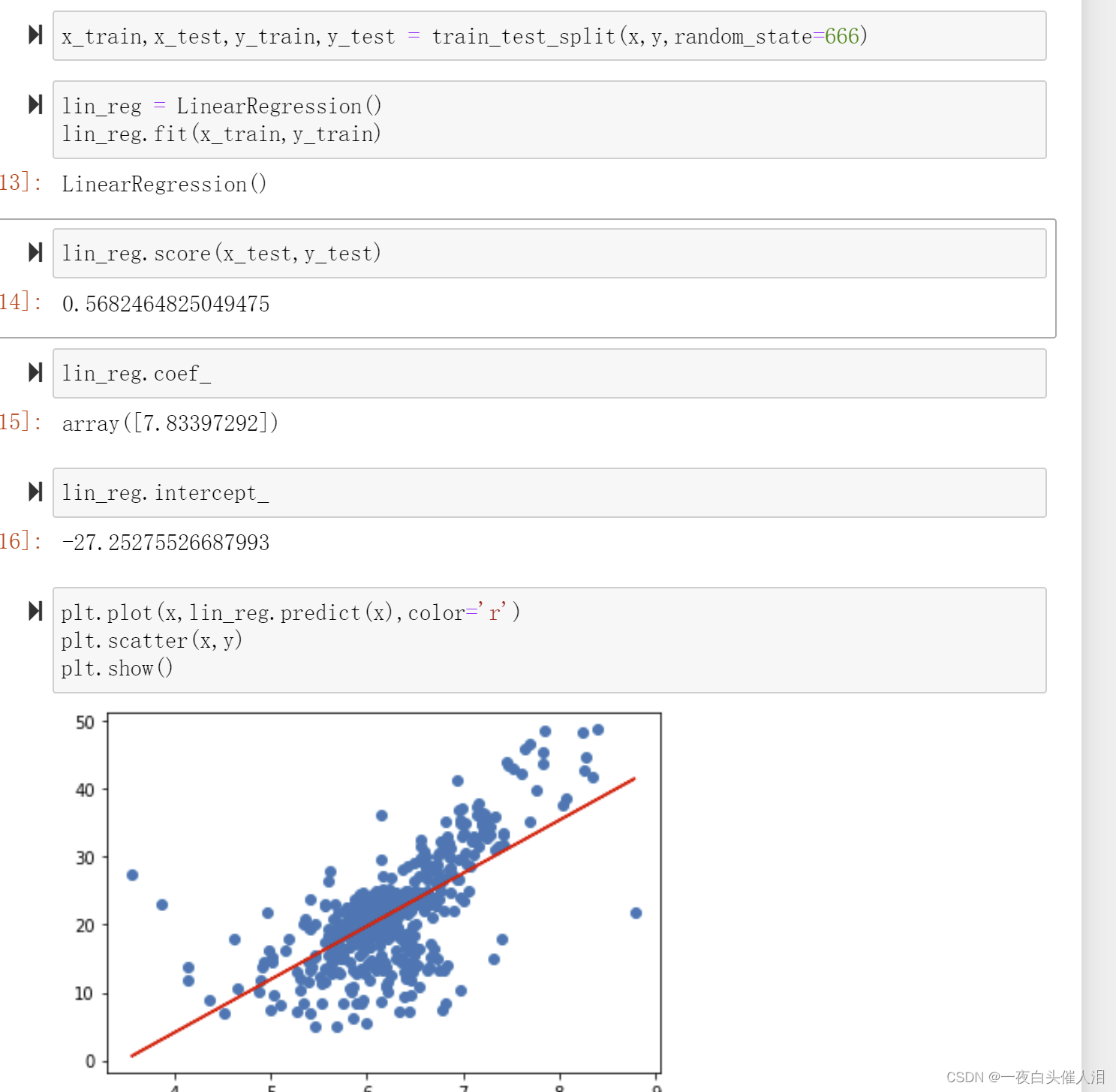

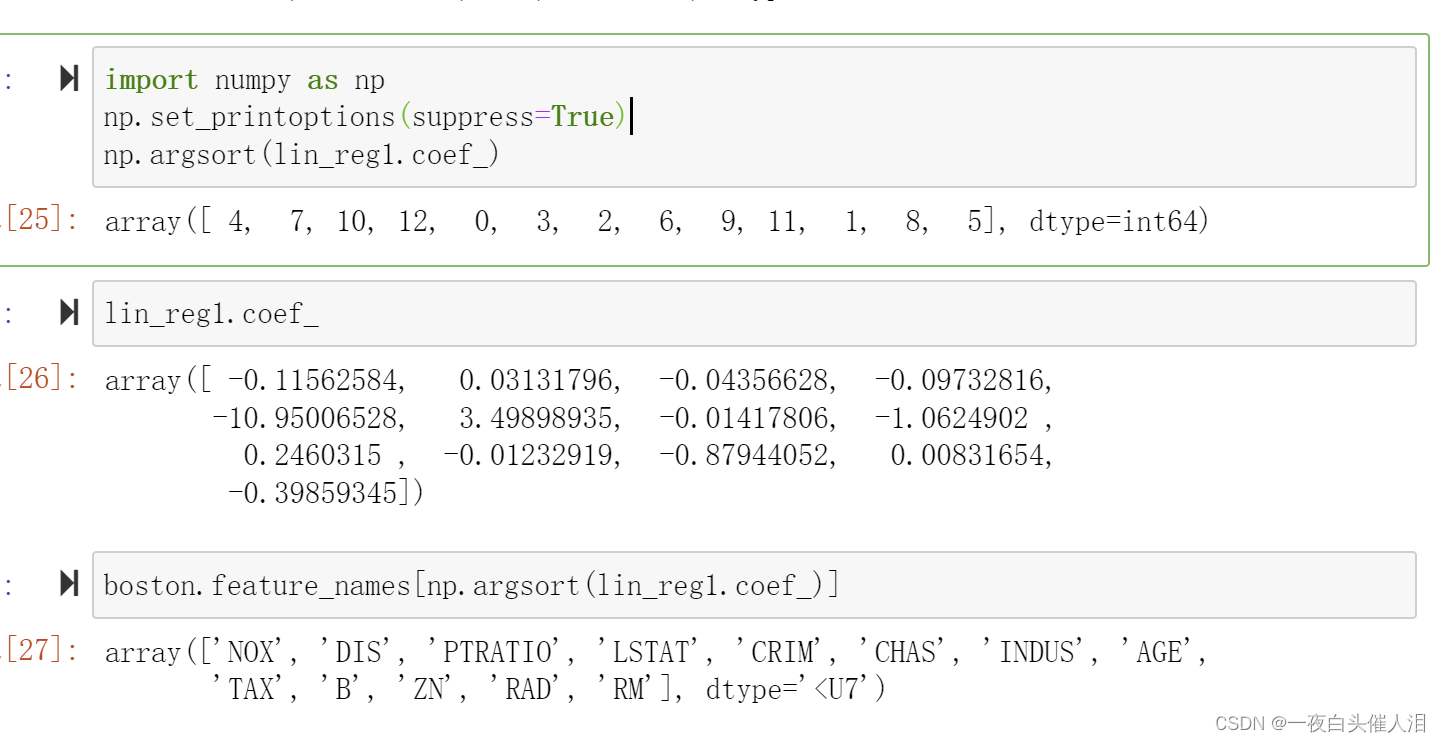
from spectral import *
from scipy.io import loadmat#读取数据并显示
input_image = loadmat('dc.mat')['imggt']
input_image_gt = loadmat('dc.mat')['imggt'][1,:,:]
v = imshow(input_image_gt)
v1 = imshow(input_image)
# principal_components计算图像数据的主组件,并返回一个主组件中的平均值、协方差、特征值和特征向量
pc = principal_components(input_image)
v2 = imshow(pc.cov)
#显示协方差矩阵 白色 强正协方差,深色 强负协方差,灰色 协方差接近于0
#保留至少99.9%的总图像方差
pc_0999 = pc.reduce(fraction = 0.99)
pc_0999.eigenvalues
#获取特征值
len(pc_0999.eigenvalues)#特征值数组长度为270
img_pc = pc_0999.transform(input_image)
v = imshow(img_pc[:,:,:3],stretch_all = True)
文章来源:https://blog.csdn.net/cxl0406/article/details/135589377
本文来自互联网用户投稿,该文观点仅代表作者本人,不代表本站立场。本站仅提供信息存储空间服务,不拥有所有权,不承担相关法律责任。 如若内容造成侵权/违法违规/事实不符,请联系我的编程经验分享网邮箱:chenni525@qq.com进行投诉反馈,一经查实,立即删除!
本文来自互联网用户投稿,该文观点仅代表作者本人,不代表本站立场。本站仅提供信息存储空间服务,不拥有所有权,不承担相关法律责任。 如若内容造成侵权/违法违规/事实不符,请联系我的编程经验分享网邮箱:chenni525@qq.com进行投诉反馈,一经查实,立即删除!
最新文章
- Python教程
- 深入理解 MySQL 中的 HAVING 关键字和聚合函数
- Qt之QChar编码(1)
- MyBatis入门基础篇
- 用Python脚本实现FFmpeg批量转换
- 01-浮点数精度问题bug
- 机器学习笔记 - 基于自定义数据集 + 3D CNN进行视频分类
- 【【IIC模块Verilog实现---用IIC协议从FPGA端读取E2PROM】】
- 行业软件龙头盈建科:以CRM推动业财一体,化繁为简助力高速增长
- LeetCode刷题--- 三步问题
- python_数据可视化_pandas_导入CSV数据
- [Flutter]WindowsPlatform上运行遇到的问题总结
- Android 相机保存照Failed to find configured root that contains 终极解决方案(终于讲明白了)
- 爬虫hook学习
- 小狐狸ChatGPT付费创作系统V2.4.7全开源版 (vue全开源端)